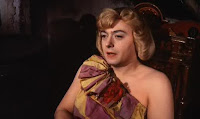The main thrust of Taliesin Meets the Vampires is to look at vampires in popular culture, books, TV and cinema in the main. However, as well as the supernatural vampire and other media spin-offs, there have been real life killers who have displayed vampiric tendencies – in other words a lust for drinking (and sometimes bathing in) blood.
One of the most infamous was Fritz Haarmann, known in the press at the time as the Hanover Vampire. His crimes were sado-sexual and he was the murderer of at least 24 young men (or at least that is what found guilty of). For more information on the real-life Haarmann the Wikipedia page for him is here and a more sensationalist write up can be found here.
Haarmann has been the focus of, or mentioned in, several films, perhaps most famously the Peter Lorre vehicle, directed by Fritz Lang, M (1931), in which his case is certainly mentioned. He has also been mentioned in vampire vehicles, an allusion to him seemed to be made during the TV movie The Night Stalker. The “Tenderness of Wolves” was a 1973 German vehicle based on the case and directed by Ulli Lommel.
The film itself is somewhat of an oddity, probably due to how they portrayed Haarmann (or at least how I felt they did). Haarmann is played by Kurt Raab and there is a clash, I felt, between portraying a sexual monster and almost trying to make Haarmann sympathetic – in as much as he was almost portrayed as sad and pathetic.
The film’s timeframe is messed up. Whilst the historical blurb mentions 1925 the film itself seemed to be in another timeframe. A cast off remark about the Nazi period didn’t help, the earlier incarnation of the party was certainly around but there was no 'period', at the time of Haarmann’s crime, to refer to. EDIT 08/11/2015 - in fact the booklet with the Blu-Ray release mentions that the filmmakers transposed the story to just after the war due to budget constraints not allowing them to make a period piece.
Haarmann is, in the eyes of corrupt inspector Braun (Wolfgang Schenck), a petty criminal and black marketer with a long rap sheet. He was picked up for solicitation of a young boy at the beginning of the film and released under the condition that he worked for the police. I am not sure if that happened but it certainly helped his actions in the film, giving him an excuse to cruise the train station picking up vagrants.
Much of the film concentrates on the various scams indulged in by Haarmann and his partner Hans Grans (Jeff Roden), which included Haarmann posing as a priest in order to collect donations of clothes which they would then sell on the black market. Whilst there is a hint to a relationship between Grans and Haarmann, artistic license has been used, making Grans unsympathetic in his dealings with Haarmann and implicit in his capture. Grans (who is sometimes called Graf, depending on the source) was imprisoned in real life due to his involvement in the crimes.
Much of the horror of the case is hinted at. Haarmann’s ability to get meat for a nearby café – and to throw dinner parties – hints at cannibalism, that he butchered his victims, without being explicit. That is fine, in that there is only a suspicion that he did so in real life. As hinted as it might be, the concept is still stomach churning.
His interaction with his victims builds, visually, as the film goes along. We see him throttle one boy, bite his neck, strip him and then drag the corpse into the bedroom. Offering a cornucopia of sado-sexual concepts that are not, necessarily, shown to the audience. Reading about the real crimes, however, the visuals do seem mild – perhaps just as well.
We hear tell of a werewolf stalking the streets – and are reminded that as well as being accused of being a vampire, he was also labelled as a werewolf by the contemporary press. The only transformation we actually see is one of gender, when Haarmann wears drag. Whilst this is a queering moment within the narrative the idea that gender fluidity is associated with homicidal tendencies is, of course, unfortunate.
The conclusion of the film sees a more vicious attack, when the boy is still alive/conscious. This attack is during a sting operation and thus the boy survives. The impetus driving the criminal is shown here as he continues to lunge for his victim, even though he is held by the police. It suggests that he was driven to do what he did.
Raab does give an extraordinary, and in many respects understated, performance. One couldn’t help but wonder whether the decision to have Haarmann portrayed bald, as they did, was to draw a simile with Nosferatu - perhaps, at this point, I am reading too much into the visuals.
I mentioned that the film tries to develop a sympathy level, however do not get me wrong. The film never tries to make us relate to Haarmann but shows him in a sad light, abused by those he is closest to and driven to perverse impulses. The man himself, still comes across as repulsive and that is where the film fails as the pathetic character never gels with the repulsive character. There is some lovely atmosphere generated in the shots but the film does meander in an arty way without drawing the thriller aspects, which are necessary, to the fore. Interesting, flawed and an insight into a dark piece of criminology.
The imdb page is here.

























No comments:
Post a Comment